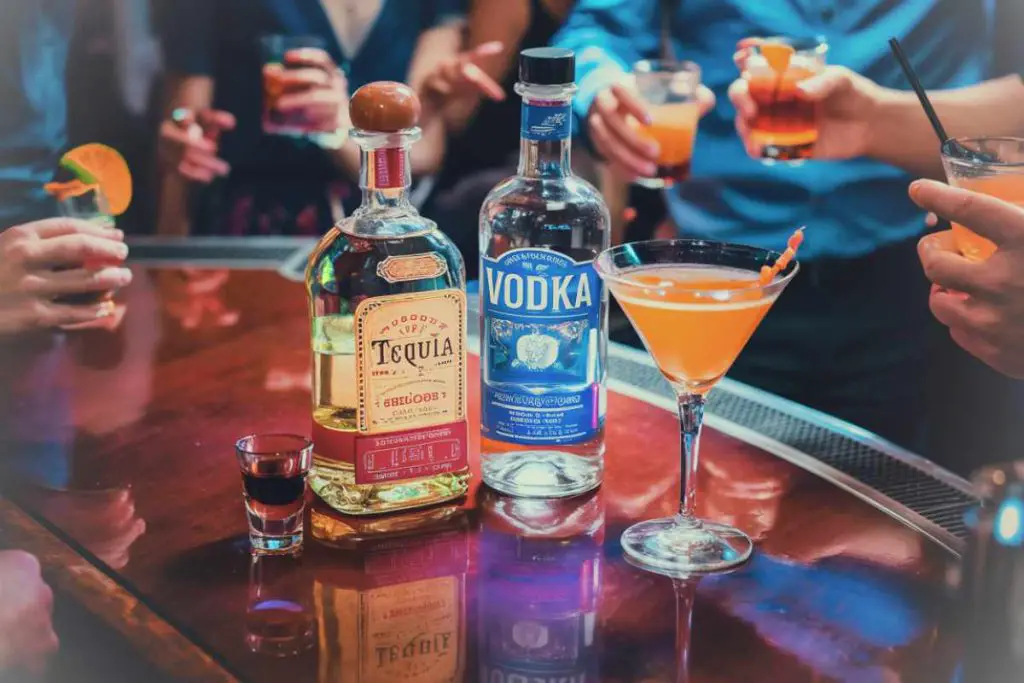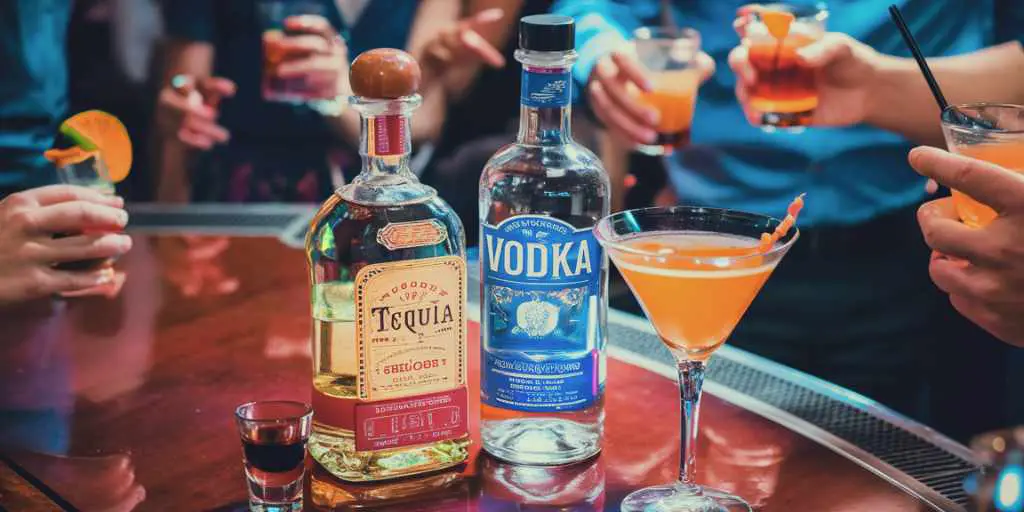Tequila and Vodka
Mixing tequila and vodka can spark curiosity among cocktail enthusiasts and occasional drinkers alike. These two spirits, known for their distinct and bold flavours, often raise the question of compatibility when combined. Yes, you can mix tequila and vodka, but it’s essential to do so with caution and intention. This article explores the considerations needed to create a balanced and enjoyable drink featuring both of these potent liquors.
Tequila and vodka have unique characteristics and are celebrated in different cocktails. While tequila is typically associated with margaritas and palomas, vodka is found in martinis and screwdrivers. When mixed, the contrasting tastes can create innovative and refreshing cocktails. Experimenting with small quantities to find the right balance is key to harmonious blending.
Responsible drinking remains paramount, especially when dealing with high-proof spirits like tequila and vodka. Knowing your limits and understanding the effects of alcohol are crucial for a safe and pleasant drinking experience. Following these guidelines allows you to explore the exciting possibilities of combining these two popular liquors.
Key Takeaways
- Mixing tequila and vodka is possible with careful consideration.
- Both spirits have unique flavours and are used in different cocktails.
- Responsible consumption is essential for a safe drinking experience.
Understanding Alcoholic Beverages
Alcoholic beverages come in various forms, each with unique characteristics. They broadly fall into three main categories: beer, wine, and spirits.
Beer is typically made from barley, hops, water, and yeast. It is usually fermented and brewed over several weeks.
Wine is produced by fermenting grapes. The process involves crushing the grapes and allowing the natural yeast to convert the sugars into alcohol.
Spirits are distilled beverages with higher alcohol content. This category includes tequila, vodka, rum, whiskey, and gin. The distillation process involves heating the liquid to create vapor and then cooling it to concentrate the alcohol.
Popular Spirits: Tequila and Vodka
Tequila, made from the blue agave plant, originates from Mexico. It comes in various types, such as Blanco, Reposado, and Añejo, reflecting different ageing processes.
Vodka is typically distilled from grains or potatoes and is known for its neutral flavour profile. It is a popular choice for cocktails due to its versatility.
| Spirit | Primary Ingredient | Origin | Characteristics |
|---|---|---|---|
| Tequila | Blue Agave | Mexico | Distinctive flavour, various ageing types |
| Vodka | Grains or Potatoes | Eastern Europe | Distinctive flavor, various ageing types |
Each alcoholic beverage offers distinct flavours and experiences, providing diverse options for any preference.
Overview of Tequila
Tequila, a spirit distilled from the blue agave plant, has a rich history originating from Mexico. Various types of tequila exist, each offering distinct flavour profiles. Understanding these elements enhances the appreciation of this versatile drink.
Origins and Production
Tequila’s origins date back to the 16th century in Mexico. Indigenous peoples fermented agave long before the Spanish arrived. Modern distillation began when Spanish settlers fermented the agave’s sap.
Production involves harvesting the blue agave plant, cooking the hearts to extract sugars, fermenting the juice, and distilling it twice. The final product is usually aged for varying periods to develop its flavour. Major production regions include Jalisco and certain areas in Guanajuato, Michoacán, Nayarit, and Tamaulipas.
Types of Tequila
Tequila is categorized based on ageing:
- Blanco: Unaged or aged up to two months, clear in colour, with a strong agave flavour.
- Reposado: Aged between two months and one year in oak barrels, giving it a golden hue and smoother taste.
- Añejo: Aged between one to three years, featuring deeper amber colour and complex flavours.
- Extra Añejo: Aged over three years, offering a rich and intricate flavour profile.
- Joven: A blend of Blanco and aged tequilas.
Each type provides a unique tasting experience based on ageing and production methods.
Tequila Tasting Notes
Blanco tequila has a fresh, pure agave flavour with notes of citrus and pepper, making it ideal for cocktails. Reposado tequilas offer a balance of agave and oak, with hints of vanilla and caramel. Añejo tequilas provide richer, more complex oak, chocolate, and spice notes.
Extra Añejo tequilas are luxurious, with deep flavours of dried fruit, honey, and tobacco. Joven, being a mix, captures elements from both Blanco and aged varieties, presenting a versatile taste. Proper tasting involves noting the aroma, appearance, and flavour layers, often best enjoyed neat or with a slight chill.
Overview of Vodka
Vodka is a versatile and widely consumed spirit known for its clear appearance and neutral flavour. It is primarily made from grains or potatoes and undergoes a precise distillation process.
Distillation and Varieties
Vodka is typically distilled multiple times to achieve its characteristic purity. The distillation process involves heating the base ingredient, which can be grains such as wheat, rye, corn, or potatoes. This repeated distillation helps to remove impurities and results in a higher alcohol content, usually around 40% ABV (alcohol by volume).
There are several varieties of vodka, including plain, flavoured, and infused types. Flavoured vodkas add different essences, such as citrus, berries, or herbs, during the distillation process or by adding natural flavours later. Infused vodkas are made by steeping ingredients in the spirit to extract flavours more naturally over time.
Flavor Profile
Vodka is famous for its neutral flavour, which is why it is a favourite in many cocktails and mixed drinks. Its purity results in a clean, almost bland taste, but subtle differences can be detected based on the ingredients used and the number of distillations it undergoes.
Flavoured vodkas offer a variety of taste experiences by incorporating flavours like vanilla, raspberry, or chilli pepper. High-quality vodkas are smoother and less harsh than their lower-quality counterparts, making them more pleasant to sip neat or on the rocks.
Popular Vodka Brands
Several vodka brands have gained international acclaim for their quality and distinct characteristics. Absolut is renowned for its wide range of flavoured vodkas and stylish bottle designs. Grey Goose, made from French wheat, is celebrated for its smooth finish and premium taste.
Smirnoff is one of the most widely recognized brands globally, offering plain and flavoured varieties. Tito’s Handmade Vodka from Texas is praised for its handcrafted production process and smooth texture. Each brand brings unique qualities, catering to different preferences and occasions.
Effects of Alcohol on the Body
Alcohol has both short-term and long-term effects on the body, impacting various systems, including the liver, brain, heart, and metabolism. Understanding these effects can help inform drinking behaviour and health decisions.
Short-Term Effects
In the short term, alcohol consumption can lead to several immediate effects on the body. Alcohol is a depressant that affects the central nervous system, often resulting in impaired coordination, slow reaction times, and reduced cognitive function. Drinking increases the risk of accidents and injuries due to impaired judgment.
Alcohol can also disrupt sleep patterns, causing difficulty in falling asleep or staying asleep. Additionally, alcohol consumption may cause dehydration and electrolyte imbalances, leading to hangover symptoms such as headaches, nausea, and fatigue.
Furthermore, even moderate drinking can significantly alter mood and behaviour. While some may experience euphoria initially, alcohol often leads to mood swings and increased emotional volatility.
Long-Term Effects
Long-term excessive alcohol use has more severe impacts on the body. Chronic drinking can lead to liver diseases such as fatty liver, hepatitis, and cirrhosis. The liver is crucial in metabolizing alcohol, and persistent abuse can cause irreversible damage.
Alcohol consumption over time can also affect the brain, leading to cognitive impairments, memory loss, and possible development of mental health disorders such as depression and anxiety.
Cardiovascular health is another area affected by prolonged alcohol use. Drinking can contribute to high blood pressure, arrhythmias, and an increased risk of heart disease.
Digestive issues are not uncommon, with alcohol contributing to gastritis, pancreatitis, and an increased risk of gastrointestinal cancers.
Persistent alcohol use weakens the immune system, making it difficult for the body to fight off infections. This can leave long-term drinkers more susceptible to illnesses.
While moderate drinking may have some perceived benefits, the potential long-term risks are substantial and should be carefully considered.
Responsible Drinking Practices
Practising responsible drinking involves knowing your personal limits, staying hydrated, and avoiding risky behaviours that can lead to harm. Below are specific guidelines to help ensure a safe and enjoyable experience.
Understanding Limits
Knowing your own tolerance for alcohol is key. Everyone’s limits vary based on body weight, age, and other factors. It is recommended to keep track of the number of drinks consumed and their alcohol content.
Here’s a quick reference table:
| Drink Type | Standard Measure | Approximate Alcohol Content |
|---|---|---|
| Beer | 12 oz | 5% |
| Wine | 5 oz | 12% |
| Spirits (Vodka, Tequila, etc.) | 1.5 oz | 40% |
Understanding these values helps you stay within safe limits. Professional guidelines suggest that men should limit their consumption to two drinks per day and women should limit their consumption to one.
Hydration and Food Intake
Alcohol consumption can lead to dehydration. It is essential to drink water regularly while consuming alcohol. A good practice is to alternate between alcoholic beverages and water.
Additionally, eating before and while drinking slows alcohol absorption. Foods rich in fats and proteins, such as nuts, cheese, and meats, are particularly effective. Here are some snack ideas:
- Nuts and seeds
- Cheese and crackers
- Grilled chicken skewers
These taste great and help mitigate the effects of ethanol on an empty stomach.
Avoiding Risky Behaviors
Staying safe while drinking means avoiding behaviours that can cause harm. This includes refraining from mixing alcohol with medications as it can lead to dangerous interactions. It’s also wise to avoid activities that require coordination and quick reflexes, like driving or operating heavy machinery, after drinking.
Social settings can be unpredictable. It’s best to stick to a pre-determined number of drinks and never leave your beverage unattended. Trustworthy companions can offer support and help monitor intake.
By following these guidelines, one can enjoy tequila and vodka responsibly.
Mixing Different Alcohols
Mixing different types of alcohol, such as vodka and tequila, can lead to varied experiences and outcomes. Factors like the individual’s tolerance, the mixing method, and moderation play crucial roles.
Potential Risks
Mixing different alcohols can increase the risk of overconsumption. Each type of alcohol has its unique properties and effects on the body. Combining them can result in a higher blood alcohol concentration more quickly. This increases the chances of experiencing stronger and quicker effects, which can sometimes lead to alcohol poisoning. Knowing one’s limits and consuming mixed drinks slowly can help manage these risks.
Additionally, mixing alcohol can cause severe hangovers. Different alcoholic beverages contain various congeners, which are by-products of fermentation. These congeners can intensify hangover symptoms. For instance, darker spirits like whiskey generally contain more congeners than clear spirits like vodka or tequila, making hangover severity unpredictable when mixed.
Myths and Facts
Several myths surround mixing alcohol. One common saying is, “Beer before liquor, never been sicker.” However, the order of consuming alcohol types is less significant than the total amount consumed. It’s not about mixing different types of alcohol but about how much one drinks altogether.
Another myth is that mixing different alcohols always leads to worse hangovers. While certain combinations might increase hangover severity due to congeners, moderation and hydration are more critical factors. Scientific findings show that the type of alcohol matters less than the volume and drinking habits in determining next-day effects.
Lastly, some believe mixing alcohol leads to quicker intoxication. Mixing can make it easier to drink more over time since the flavours might blend smoothly. Ultimately, intoxication levels are based on the total amount of alcohol consumed, not the mix.
Cocktails and Mixed Drinks Basics
Tequila and vodka are versatile spirits enjoyed in various cocktails and mixed drinks. Both have unique characteristics and can be used together or separately to create refreshing and delicious beverages.
Popular Cocktail Recipes
Vodka Martini: A classic cocktail combining vodka and dry vermouth, usually garnished with an olive or a lemon twist. It’s simple yet elegant.
Margarita: This popular tequila-based drink consists of tequila, lime juice, and orange liqueur, often served with a salted rim.
Paloma: Made with tequila, grapefruit soda, and lime juice, a Paloma is refreshing and can be further enhanced with fresh grapefruit juice for extra citrus flavour.
Soul Taker: This potent drink blends the bold flavours of vodka and tequila with the sweetness of amaretto, creating a unique taste experience.
Mixing Techniques
Shaking: Shaking is ideal for cocktails featuring fruit juices, dairy, or other mixers that need to be thoroughly combined and chilled. Use a shaker filled with ice and shake vigorously before straining into a glass.
Stirring: Stirring is preferred for cocktails made solely with spirits, such as a Martini or Manhattan. Stir gently with ice to avoid diluting the drink too much.
Layering: This technique involves carefully pouring ingredients over the back of a spoon to create visually appealing layers in the glass. It’s commonly used in cocktails like the B-52.
Muddling: Used to release the flavours of fresh ingredients like herbs and fruits, muddling involves gently crushing them in the bottom of a glass or a shaker before adding the other components.
Using these techniques, one can craft a wide array of tequila and vodka cocktails that cater to different tastes and preferences.
Legal and Cultural Considerations
When mixing vodka and tequila, different legal and cultural norms around alcohol consumption need to be understood. These norms vary greatly by region and can impact your experience and legal standing.
Drinking Age and Laws
Various countries have different legal drinking ages, which determine when individuals can start consuming alcohol. In the United States, the legal drinking age is 21. In contrast, countries like Spain allow drinking from the age of 18.
Alcohol laws don’t just stop at age restrictions. Some regions have specific regulations on public intoxication and the sale of alcohol. For example, certain U.S. states have “dry” counties where alcohol sales are prohibited.
Understanding local laws is critical. Violation can lead to severe penalties, including fines or imprisonment. Always check the regulations of your area before consuming or mixing alcohol like vodka and tequila.
Cultural Attitudes Towards Alcohol
Cultural attitudes towards alcohol vary extensively around the world. In countries like France and Italy, alcohol is often integrated into daily life and meals. Drinking is seen as a social activity and an important part of the culture.
In contrast, some cultures hold a more restrictive or negative view of alcohol consumption. For instance, in many Middle Eastern countries, alcohol is prohibited due to religious beliefs. Public consumption of alcohol can be socially frowned upon or even illegal.
Understanding cultural attitudes when mixing and consuming drinks like vodka and tequila can help avoid social faux pas. It also ensures respectful and responsible behavior in diverse settings.
Identifying and Addressing Alcohol Abuse
Identifying the Signs
Recognizing alcohol abuse can be challenging but crucial. Common signs include:
- Frequent Intoxication: Regularly drinking to the point of impairment.
- Neglecting Responsibilities: Missing work or important obligations due to drinking.
- Health Issues: Symptoms such as liver damage, memory loss, or persistent fatigue.
Behavioral Red Flags
Behavioural changes often signal alcohol abuse:
- Isolation: Avoid social situations that do not involve alcohol.
- Mood Swings: Experiencing unexplained irritability or depression.
- Increased Tolerance: Needing more alcohol to achieve the same effects.
Addressing Alcohol Abuse
Addressing alcohol abuse requires a multi-faceted approach:
Self-help Strategies:
- Limit Quantity: Set and adhere to a personal drink limit.
- Avoid Triggers: Identify and avoid situations that prompt excessive drinking.
Professional Help:
- Therapy: Seek counselling or join support groups like AA (Alcoholics Anonymous).
- Medical Treatment: Consult healthcare providers for potential medication or detox programs.
Support Networks
- Family and Friends: Rely on trusted individuals for support and accountability.
- Community Resources: Utilize local resources such as helplines and community programs.
Monitoring Progress
Regularly evaluate the effectiveness of strategies employed:
- Journals: Keep a diary to track drinking patterns and triggers.
- Health Check-ups: Schedule regular appointments to monitor physical and mental health.
Resources Table
| Resource Type | Example |
|---|---|
| Support Groups | Alcoholics Anonymous (AA) |
| Medical Help | Detox Programs, Medication |
| Community Resources | Local Helplines, Community Centers |
Hosting and Attending Social Events with Alcohol
Hosting Tips
When hosting a social event that includes alcohol, it is essential to plan clearly. Stocking a variety of beverages ensures guests have options. Providing mixers, non-alcoholic drinks, and plenty of water for hydration is considerate and helps prevent overconsumption.
Creating a Signature Drink
A signature drink can add a unique touch. For example, combining tequila and vodka in a new cocktail can intrigue guests. Always use high-quality spirits to enhance the flavour.
Serving Responsibly
Limit the amount of alcohol served per drink and keep track of how much guests are consuming. Encourage responsible drinking and be prepared to call a taxi or arrange transportation for those who may need it.
Attending Tips
When attending an event with alcohol, pace yourself. It’s beneficial to alternate alcohol with non-alcoholic beverages or water. Consuming food throughout the event can also help moderate the absorption of alcohol.
Mixing Spirits
Combining different spirits like tequila and vodka can create interesting cocktails. Cocktails such as the Long Island Iced Tea already incorporate multiple liquors. Ensuring these drinks are mixed well can enhance enjoyment and mitigate potential discomfort from improper mixing.
| Tips for Social Events With Alcohol |
|---|
| Provide a variety of drinks |
| Ensure plenty of water is available |
| Offer non-alcoholic options |
| Create a signature cocktail |
| Monitor and limit alcohol intake |
Being mindful of these practices can result in a safer and more enjoyable social experience for everyone involved.

Frequently Asked Questions
Mixing tequila and vodka raises several questions about safety, effects, and best practices. This section addresses common inquiries to help individuals make informed decisions when combining these two popular spirits.
Is it safe to mix tequila and vodka in one drink?
Yes, mixing tequila and vodka in one drink is generally safe. Both are distilled spirits, and combining them won’t necessarily pose a health risk if consumed responsibly and in moderation. It is always important to use high-quality alcohol to avoid adverse reactions.
What are the effects of drinking tequila followed by vodka?
Consuming tequila, followed by vodka, can amplify the effects of alcohol due to their high alcohol content. This may lead to quicker intoxication. While both spirits are similar, mixing them can increase the intensity of alcohol’s effects on the body, leading to quicker impairment.
How does combining tequila with vodka affect your hangover?
Mixing tequila and vodka might result in a more severe hangover compared to sticking with one type of alcohol. The combination can lead to higher overall alcohol consumption, which is a primary factor in hangover severity. Drinking water and staying hydrated can help mitigate these effects.
Are there any specific cocktails that feature both tequila and vodka?
Yes, some cocktails feature both tequila and vodka. One example is the “Tequila Sunrise Martini,” which combines both spirits with orange and grenadine flavors. These cocktails are not as common as single-spirit drinks but exist for those who enjoy mixing their flavours.
Is it more likely to get sick by mixing tequila with vodka as opposed to drinking them separately?
No, mixing tequila with vodka is not more likely to make you sick as long as the alcohol is of good quality and consumed sensibly. The likelihood of getting sick primarily depends on the quantity consumed and the individual’s tolerance to alcohol, not necessarily on combining different spirits.
What precautions should one take when drinking different types of alcohol in one sitting?
When mixing different types of alcohol, it is essential to drink plenty of water and eat food to mitigate the effects. Monitoring the number of drinks consumed and pacing oneself can prevent over-intoxication. Avoiding excessive consumption and staying aware of one’s limits are key precautions.
For more information on this topic, check out these articles on mixing vodka and tequila and the effects of combining alcohol sources.




